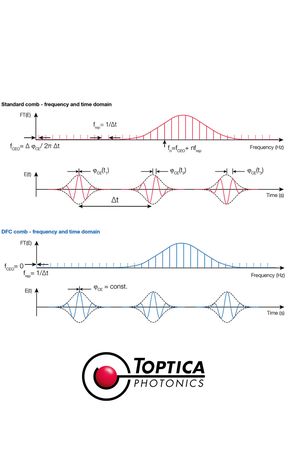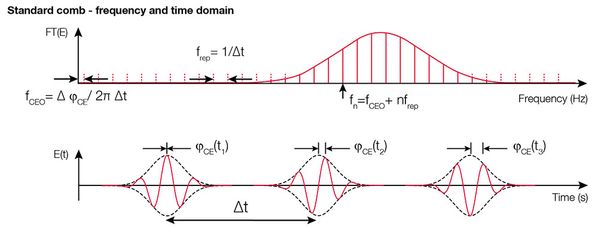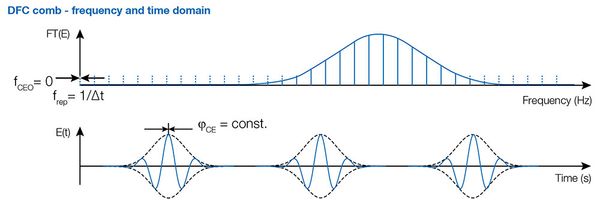TOPTICA Tuesday – Frequency Comb Basics
Frequency combs are very precise tools which are used for applications that require highest accuracy and resolution to measure the frequency of light. A frequency comb has an optical spectrum that consists of equidistant lines in the frequency domain. These lines serve as reference to measure unknown frequencies or to stabilize a laser to a certain frequency.
The discrete spectrum in the frequency domain corresponds to a regular train of ultrashort laser pulses in the time domain. This can be generated using a mode-locked laser oscillator whereas the repetition rate frep of the laser pulses corresponds to the distance between the discrete lines of the spectrum.
In addition, the so-called carrier-envelope offset frequency fCEO is given by the offset of the periodic spectrum from zero. A mode-locked laser is usually called a frequency comb when both degrees of freedom, fCEO and frep, are stabilized to a frequency reference. In this case, the discrete spectrum adopts the absolute stability of the reference and can therefore be used as an "optical ruler". The performance of a frequency comb is thus given by the choice of reference and the ability to stabilize its phase and frequency fluctuations to this reference.
A non-zero carrier-envelope offset frequency fCEO is caused by a phase slip between the envelope and carrier of subsequent pulses, the carrier envelope phase (CEP) φCE. The typical method to stabilize fCEO in a standard comb relies on complex self-referencing methods and an active feedback loop to compensate for phase and frequency fluctuations. Their performance is limited by the finite bandwidth of the electronic feedback circuit. Another disadvantage of this method is that usually the actuators used for stabilizing fCEO and frep are not fully decoupled, i.e. they have an effect on both parameters. In practice, this means that if one parameter is tightly locked to a reference, the other suffers from additional unwanted broadening. Additional intra-cavity EOMs used to circumvent this add unnecessary complexity.
CERO: Inherently noise-free
TOPTICA’s unique difference frequency comb DFC implements the completely passive CERO technology, which inherently stabilizes fCEO and the carrier envelope phase. The DFC is the first commercial system based on this superior patented technology (patent number: DE102004022037). The fiber-based comb combines the convenience and robustness of fiber lasers with low-noise performance.
The operating principle of TOPTICA’s frequency combs relies on a more than octave-spanning super-continuum generated from of a low noise Er-fiber modelocked oscillator at 1560 nm and subsequent difference frequency generation (DFG) between certain low- and high-frequency parts of the spectrum in a nonlinear optical crystal. This results in a new frequency comb at 1560 nm with a simplified and reliable, all-passive fCEO stabilization. The new comb is free from fluctuations of the CEP and fCEO due to the common mode suppression of the two parts of the original spectrum. Additionally, the fCEO of the comb is fixed to zero.
Additionally, the fCEO of the comb is fixed to zero. The DFG method has been characterized by A. Liehl et al., Optics Letters Vol. 42, Issue 10 (2017) using an ultrabroadband out-of-loop method showing record stability and integrated phase noise values. "This result compares favorably with the record performance demonstrated for actively stabilized combs…."
All TOPTICA frequency comb systems employ this CERO technology ("zero-fCEO"). To stress the importance of the DFG process, TOPTICA’s frequency comb product line is named DFC: Difference Frequency Combs:
- DFC CORE / DFC CORE+: Low-noise frequency comb
- Complete DFC Systems: Complete, stabilized laser systems
- DFC SDL: Rack-mounted, complete, stabilized laser systems



